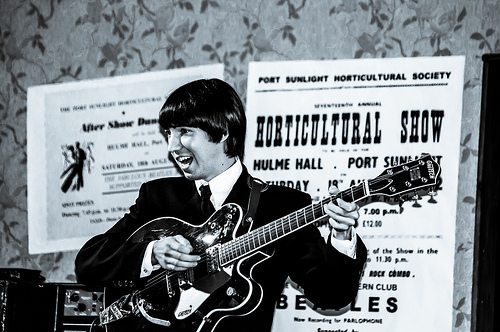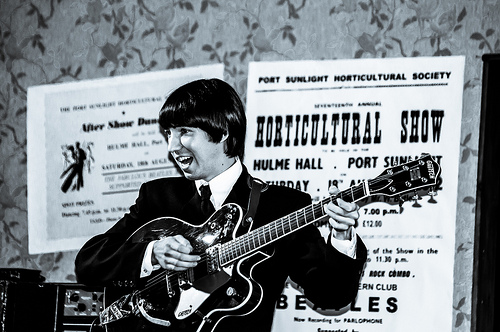So we’ve all been told at some point that a good popular song is defined by a great chorus, some mellow verses, and maybe a bridge or instrumental. I am not denying that this verse-chorus structure is often very successful (and has brought us some great music), but can’t we sometimes be a bit too comfortable? Isn’t it nice to sometimes be surprised by the unexpected? This article aims to help songwriters step outside of their self-made metaphorical box with some help from some well-known (and some less well-known) masters of the craft. This can also be a great cure for writers block…
Taking a closer look (or more correctly, listen)
Each example used here refuses to conform, and fails to use a chorus or seemingly doesn’t follow any structure at all. The article will establish how each example differs from the norm, and tries to answer the question “Why does it work?” or maybe “Why doesn’t it work?” Below this are 3 different styles and songwriting structures, a band/artist that best encaptulates each one, and an explanation on what makes the music successful, or ‘gel’ together with the absence of a chorus.
1. A continuous repeating verse
Squeeze – Up the Junction
Squeeze are a British band from the 1970s. In ‘Up the Junction’, they completely ignore any concept of a chorus, and instead leave the listener with the same very simple melody and three chords pretty much on repeat for three minutes. This is still a well-known and popular song, so how does the song manage keep the audience’s attention?:
- A catchy melody
The melody used in the verses is very catchy, and therefore allows
itself to be repeated:E.g. YouTube video: 0:12 – 0:32
- Guitar hook
Instead of using a vocal ‘hook line’ that would normally be found in a
chorus, the song has a prominent recurring guitar riff in the intro and
outro that helps to hold the track together:E.g. YouTube video: 0:00 – 0:12
- Conversational style lyrics
Lyrics are very important in this track. There is very little repetition, and instead the vocals have a conversational style to them – it tells a story that keeps the listener engaged:
“I got a job with Stanley
He said I’d come in handy
And started me on Monday
So I had a bath on Sunday
I worked eleven hours
And bought the girl some flowers
She said she’d seen a doctor
And nothing now could stop her” - Key changes
As there is little melodic change, the song changes key several times in the track:E.g. YouTube video: 01:40 – 02:00
- Variation
There is a single change in chords and melody in the track that usually
follows the format of a bridge or pre-chorus, but instead goes back to
the verse:E.g. YouTube: 01:13 – 01:35
2. Classical Structures in disguise
The Beatles – A Day in the life
The Beatles are probably still the most well-known popular band, and are well known for their variety of catchy tunes as well as their periods of ‘breaking boundaries’, but they commonly use unusual structures in their songs. This song is split very clearly into 3 parts. The structure can be labelled as A-B-A, which depicts a second section being sandwiched between two versions of the first section. This is commonly used in classical music, and is referred to as ternary form (because of the three sections).
- Section A
A series of repeating verses, followed by an instrumental:Section A: 0:00 – 02:16
- Section B
A totally unrelated section, comprising of a couple of verses, followed by a second break from the main vocals, with just “aahs” being used:Section B: 02:16 – 03:19
- Section A (Variation)
A shorter return to the first section (with just one verse), followed again by a final instrumental:Return to section A: 03:19 – 05:06
So why does this work?
The two sections are distinctly different from one another, so to hold it together an orchestral section was introduced and the instrumentalists were invited to improvise. This, instead of sounding random, creates a ‘dream like’ feel to the music, and when the second section comes in with “woke up, got out of bed”, it seems quite fitting. This is a great example of music and lyrics working seamlessly together. This bridge between the sections was accented by a use of audio effects (Particularly reverb):
Instrumental Section: 1:44 – 2:20
Also, although the move away from the first section is at first a little disconcerting, it makes the move back to it at the end more gratifying, making the song feel ‘complete’ and creating an ‘audio journey’ for the listener.
3. An extended instrumental
Fiona Apple – Waltz (better than fine)
Fiona Apple is an American singer-songwriter, and is reknowned for
her alternative piano and vocals, often adopting both jazz and classical styles within her music. Her song “waltz” is a great example of a song that positions itself around the instrumental rather than the other way around. The song has several demonstrable features that lend itself to this structure:
- A prominent 3/4 time signature
The ‘waltz’ feel is created by the song being in 3/4 time throughout,
compared with the much more usual 4/4 time that is used in most pop
songs. This lends itself to a more classical style, allowing the track to ‘roll forward’. This in itself creates interest for the listener, who is pulled along by the rhythmic sway of the music, and allows the track to deviate from a more traditional path.E.g. 00:00 -00:16
- A slow build up
The introduction uses just piano originally, building in volume for when
the vocals come in for the first verse (0:51). If you listen, a clarinet is
introduced in the second verse (01:08), followed by a small orchestral section.(01:29)
When the third verse comes in after the first instrumental, the listener
finally hears the drums and the full orchestra added to the vocals. (02:28). This gives the listener something new to focus their attention on and stops them from potentially getting bored: - Varied instrumentation
As mentioned in the last point, a large amount of different and unusual
instruments (for a pop song) are used in this. This not only makes it
exciting, but also plays with the listeners ears as it weaves different
textures through the music:Instrumental: 01:55 – 02:28
- Appropriate lyrics
Although I said previously that this song is based around the instrumentals, that is not entirely true, as they seem to spring out of the words sung in the verses:“I don’t believe in the wasting of time.
I don’t believe that I’m wasting mine”This allows the track to meander around, as it emphasises the few
words that are sung. Another example of music and lyrics working together to make something great!
There are loads of exceptions to the rule that create some of the best songs around, so it is important to sometimes find joy in the unexpected! So whether you are looking to expand your writing skills, try something new or looking for any cure to that dreaded writer’s block, give it a go for yourself!
There are plenty of other examples out there if you listen closely – Can you think of any other good examples?








